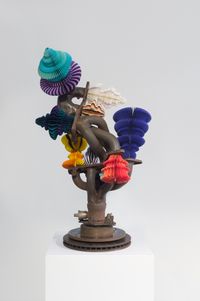
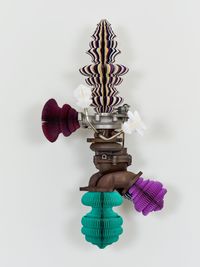
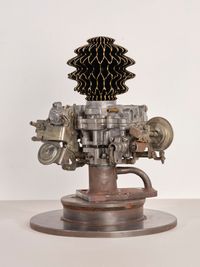
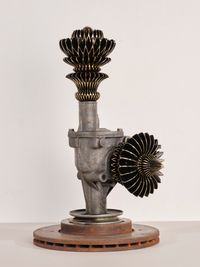
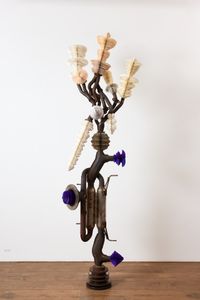
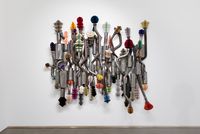
Gallery rosenfeld is delighted to present Keita Miyazaki's third solo exhibition in the gallery.
Fortuitously, the occasion coincides with a work which has just become part of The Victoria and Albert Museum's Japanese collection as well as a major loan of one of Miyazaki's large vertical floor works which will be part of the inaugural exhibition at the new Victoria and Albert Museum which will soon open in Londons' East End. The museum, which will be dedicated to children, tells you a great deal about the democracy of the artist's work. One can react to the artist's sculptures in various ways; both as a child responding to the bright rich colours of the origami, or as an adult admiring the pure beauty of the works as well as their political ramifications.
What turned out to be the major catalyst in the artist's artistic life was being a first-hand witness at the tsunami which devastated parts of his country in 2011. Seeing the total destruction of so many elements of the industrial world on which we depend for so much of our highly developed existence was a highly significant moment for him it crystallised the enormous faith in which western societies had based their progress and wealth. In the artist's head, this made him question the very basis on which Western societies measure their progress.
The artist was determined to take an element of this, in his eyes, now obsolete world and give it a renaissance in a radically different guise.That element was the components of the car engine which, drawing on his expertise as a metal welder, enabled him to combine different parts in exotic new and unsuspecting shapes to which he combined richly coloured origami inspired works made with Japanese paper. This highly original combination of materials, hard and soft and monochromatic and highly coloured and cold and hot gave him a new and fresh sculptural language, which, in the subsequent years, he has continuously developed, embracing, amongst other things, a complete reinvention of the seventeenth century Dutch vanitas using a mixture of found and made objects contained within a highly refined metal case made by the artist himself.
Our new exhibition following on from his recent solo booth at the Art Basel Fair in Hong Kong, will feature two new developments in the artist's works. Miyazaki has begun creating pedestal based sculptures, a large example of which will feature in the show. Furthermore, he has started to replace the paper elements of the sculptures with brass for the first time ever. This is a really important step for him both from an extremely difficult technical perspective and the increase of the 'preciousness' of the works. But most importantly, it also will show the difference between found metal objects and objects created by the technical skill of the artist.
The exhibition will feature Miyazaki's most ambitious wall sculpture to date, 'Excess of Desire' measuring almost 3 metres across. The artist has assembled a long line of exhaust pipes and silent mufflers welded together to form a continuum which resembles an exotic piece of vegetation on the top and on the bottom of which he has placed his richly coloured origami pieces, creating an extraordinary amalgamation of surfaces. These car parts are very important for the artist. Some are not original but self-made illegally. During Japan's economic boom in the 1980's and 1990's this playing with car engine parts which would greatly increase the noise level of the car became very desirable. These parts often had a very straight form which is why Miyazaki placed them alongside each other to exaggerate the form. The sculpture comments on the excesses of a wealthy industrial society.
Notwithstanding the originality of Miyazaki's sculptural language, his works, whether big or small, sit in space as if they were classical sculptures. The artist has an uncanny sense of how his works should hold their space yet always achieving a perfect balance and never losing their harmony within a given space.
Keita Miyazaki (*1983; Tokyo, Japan) lives and works between Tokyo and London. Miyazaki studied at Tokyo University of the Arts, Japan (2013–2015) and at the Royal College of Art, UK (2011- 2013). He also completed a PhD in craft metal casting in Tokyo. His work has been presented in numerous shows in UK and Japan, including the Victoria and Albert Museum and the Daiwa Foundation in London. A monumental work by Miyazaki was selected for Sculpture in the City exhibition in London. Miyazaki present- ed works at the Palais De Tokyo as part of the exhibition 'Childhood | Another Banana Day for the Dream Fish' and he also presented works for 'Second Hand' in Jameel Arts Centre.
His work forms part of numerous private collections in the UK, Japan, USA, Switzerland and UAE. Museum and corporate collections include; Daiwa Foundation, Mori Arts Centre Japan, Aoyama Spiral Hall Japan, Ogi Kankou Ltd, Sado Island, Niigata Prefecture Japan, Mortimer Collection London.
Forthcoming exhibition 'Japan: Myths to Manga' at The Victoria and Albert Museum, October 2023.
Press release courtesy rosenfeld.
37 Rathbone Street
London, W1T 1NZ
United Kingdom
www.galleryrosenfeld.com
+44 20 7637 1133
Mon - Sat, 11am - 6pm
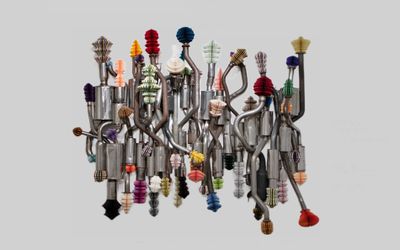
Keita Miyazaki, Excess of Desire (2021). Car parts, paper. 250 x 280 x 60 cm. Courtesy rosenfeld.